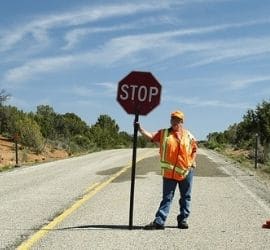What is a Stop Limit Order? Limit Orders Explained (Definition and Examples)
 What is a stop limit order? It is a conditional trade that combines the features of a stop with those of a limit order and is used to mitigate risk. It is related to other order types, including limit orders (an order to either buy or sell a specified number of shares at a given price or better) and stop-on-quote orders (an order to either buy or sell a security after its price has surpassed a specified point).
What is a stop limit order? It is a conditional trade that combines the features of a stop with those of a limit order and is used to mitigate risk. It is related to other order types, including limit orders (an order to either buy or sell a specified number of shares at a given price or better) and stop-on-quote orders (an order to either buy or sell a security after its price has surpassed a specified point).
Stop-Limit Order
A stop limit order is an order to buy or sell a stock that combines the features of a stop order and a limit order. Once the stop price is reached, a stop-limit order becomes a limit order that will be executed at a specified price (or better). The benefit of a stop-limit order is that the investor can control the price at which the order can be executed. (Source: sec.gov)
What is a Stop Order vs. Limit Order?
Different types of orders allow you to be more specific about how you’d like your broker to fill your trades. When you place a limit order or stop order, you are telling your broker you don’t want the current market price. Instead, you want your order to be executed when the stock price moves a certain amount and in a certain direction.
A limit order can be seen by the market. On the other hand, a stop order can’t be seen until it is triggered. For example, if you want to buy a $100 stock at $99 per share, then your limit order can be seen by the market. It can be filled when sellers are willing to meet that price. A stop order is a two-part order. Itwill only turn into an actual limit order seen by the market once the stop price has been met or passed. The limit order is conditional on the stop price being triggered.
Buy and Sell Limit Orders
Buy Limit Order
A buy limit order is an order to buy or sell a stock for a specific price. For example, if you wanted to purchase shares of a $100 stock at $99 or less, you can set a limit order. That way it won’t be filled unless the price you specified becomes available. However, you cannot set a plain limit order to buy a stock above the market price because a better price is already available. With a buy stop limit order, you can set a stop price above the current price of the stock. If the stock rises to your stop price, it triggers a buy limit order. Shares will only be purchased at your limit price or lower.
Sell Limit Order
Similarly, you can set a limit order to sell a stock once a specific price is available. Imagine that you own stock worth $90 per share and you want to sell if the price gets to $100 per share. A limit order can be set at $100 that will only be filled at that price or better. You cannot set a limit order to sell below the current market price because there are better prices available. With a sell stop limit order, you can set a stop price below the current price of the stock. If the stock falls to your stop price, it triggers a sell limit order. Shares will only be sold at your limit price or higher.
Stop Order
Stop orders come in a few different variations. But they are all considered conditional based on a price that is not yet available in the market when the order is originally placed. Once the future price is available, a stop order will be triggered. But depending on its type, the broker will execute them differently.
Many brokers now add the term “stop on quote” to their order types. this makes it clear that the stop order will only be triggered once a valid quoted price has been met. For example, if you set a stop order with a stop price of $100, it will be triggered only if a valid quote at $100 or better is met.
A stop order will turn into a traditional market order once your stop price is met or exceeded. A stop order can be set as an entry order as well. If you wanted to open a position once the price of a stock is rising, a stop market order could be set above the current market price, which turns into a regular market order once your stop price has been met. (Source: investopedia.com)
What is a Stop Limit Order
Combining a stop order and a limit order requires the setting of two price points.
- Stop price – The start of the specified target price for the trade.
- Limit price – The outside of the price target for the trade.
A timeframe must also be set, during which the order is considered executable. The primary benefit is that the trader has greater control over when the order should be filled. The downside, as with all limit orders, is that the trade is not guaranteed. It will not be executed if the stock does not reach the stop price during the specified time period. The order will only be executed at a specified price, or better after a given stop price has been reached. Once the stop price is reached, the order becomes a limit order to buy or sell at the limit price or better. This type of order is an available option with nearly every online broker.
Why Combine Both a Stop-Order and Limit-Order?
You may wonder what the point of using a stop-limit order is. Why not just use a stop-loss order? Consider an example to better understand stop-limit orders. Say you set a basic stop-loss order to sell 500 ABC shares if the price declines to $100. The order means you’ll sell 100 shares at the market — no matter what the price is. The trading volume on this stock is limited. There aren’t many current bids for the stock. You might be able to fill your order but at a terrible price. So you end up selling your position for much less than $100. That can mean a larger loss than you anticipated.
Now, consider the same situation, only this time you use a stop-limit order. You still want to sell 500 ABC shares if the price drops to $100. But you enter a stop-limit order with a limit of $98. So, if the price declines to $100, your broker will sell as many of the 500 shares as possible, down to a price of $98. You may be able to sell all of them or only a portion — but you won’t sell any below the $98 level.
Features of Stop and Limit Orders
By combining the two orders, the investor has much greater precision in executing the trade.
- A stop order is an order that becomes executable once a set price has been reached and is then filled at the current market price. A traditional stop order will be filled in its entirety, regardless of any changes in the current market price as the trades are completed.
- A limit order is one that is set at a certain price. It is only executable at times the trade can be performed at the limit price or at a price that is considered more favorable than the limit price. If a trading activity causes the price to become unfavorable in regards to the limit price, the activity related to the order will be ceased.
A stop order is filled at the market price after the stop price has been hit. This is regardless of whether the price changes to an unfavorable position. This can lead to trades being completed at less than desirable prices should the market adjust quickly. By combining it with the features of a limit order, trading is halted once the pricing becomes unfavorable, based on the investor’s limit. Thus, in a stop-limit order, after the stop price is triggered, the limit order takes effect to ensure that the order is not completed unless the price is at or better than the limit price the investor has specified.
Example of a Stop Limit Order
For example, assume that Netflix Inc. (NFLX) is trading at $470.00 and an investor wants to buy the stock once it begins to move in an uptrend. The investor has put in a stop-limit order to buy with the stop price at $480.00 and the limit price at $485.00. If the price of NFLX moves above the $480.00 stop price, the order is activated and turns into a limit order. As long as the order can be filled under $485.00, which is the limit price, the trade will be filled. If the stock gaps above $485.00, the order will not be filled.
Buy stop-limit orders are placed above the market price at the time of the order, while sell stop-limit orders are placed below the market price.
Risks
Stop-limit orders offer many advantages, but in exchange for having control over the price you’re paying or accepting, you’ll face some tradeoffs. Understanding the many factors that affect how or whether a stop-limit order is executed can help you determine which risks you want to take.
- No execution – Stop-limit orders allow you to achieve a certain price or better. But they don’t guarantee that execution will occur because the price may never meet or beat your limit price. Even if trading activity brings the price up to the limit order price for a short time, and execution still might not occur if other orders ahead of yours use up all or part of the shares available at the current price.
- Partial fills – There’s also the risk of a “partial fill,” or execution of some of the shares in your order but not all of them, which leaves the unfilled shares as an open order.
Limiting Risk
This is an important point in planning for commission costs, particularly with GTC orders. Multiple fills on a single order within a single trading day only involve one commission since all of the fills occur on the same day. However, executing parts of a single order across multiple days involves a commission for each trading day in which an execution actually occurs. If an order executes over four days, you’ll pay four separate commissions. You can lower the risk of partial executions by specifying certain conditions in your limit order. “All or none,” “fill or kill,” “immediate or cancel,” and “minimum quantity” are all special conditions that can refine your order to suit your trading strategy. Keep in mind, though, that special conditions can further reduce the chance of your order being executed. (Source: schwab.com)
Even if the limit price is available after a stop price has been triggered, your entire order may not be executed if there wasn’t enough liquidity at that price. For example, if you wanted to sell 500 shares at a limit price of $475, but only 300 were filled, then you may suffer further losses on the remaining 200 shares. A stop order avoids the risks of no fills or partial fills. But because it is a market order, you may have your order filled at a price much worse than what you were expecting.
Up Next: PurePlay – What is a Pure Play Company or Business Model?
A pureplay is a company that focuses on a single type of product or service. The opposite of a pureplay is a diversified company or conglomerate. Conglomerates offer many products and services across various industries. Some investors prefer investing in pure plays because they are easier to analyze and give maximum exposure to a focused market segment. For instance, an investor who wants exposure to electric cars might prefer buying Tesla stock as compared to General Motors. This is because GM is involved not only in hybrid and electric cars but also in diesel and conventional automobiles as well.



